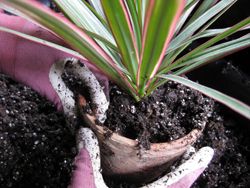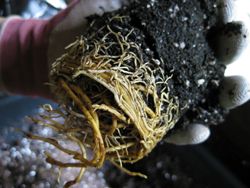Best Time for Repotting Plants
 There are a few schools of thought about the best time for repotting plants. Our answer is whenever your plant needs it, regardless the time of year. If you are re-potting simply to freshen the soil, or because your current container is 'so last season' then the best time for you is spring. The sun is stronger, days are longer, and plants are actively growing and can take the stress better.
There are a few schools of thought about the best time for repotting plants. Our answer is whenever your plant needs it, regardless the time of year. If you are re-potting simply to freshen the soil, or because your current container is 'so last season' then the best time for you is spring. The sun is stronger, days are longer, and plants are actively growing and can take the stress better.
How do you know the best time for repotting plants, you ask? If your plant is so happy that it has overwhelmed the container, roots are emerging from the drainage hole and/or lying exposed on the surface and new growth and blooms are minimal then it is time to go shopping (yay!) for a larger container. Another way to tell is to pop the plant out of its container. You can do this by placing one hand around the base of the plant, tipping it upside down, and tapping the side of the pot with your other hand. If you see one big mass tangle of roots, your plant is becoming root-bound and needs a bigger home. If you notice black, weak roots and/or an unpleasant odor, you most likely do not have adequate drainage or you have poor soil conditions, and it is time to re-pot.
Even if your plants aren't showing any of these obvious signs for re-potting, it would be a good idea to do it every few years anyway. Some plants are more slow-growing than others, or maybe you started with a really large pot right out of the gate. The reason to periodically re-pot is because the soil will eventually lose its texture and will become overloaded with deposits from water and fertilizer.
 When you are choosing a container, make sure to get one at least 1"-2" larger than the current pot, and that it has a drainage hole. Holes are necessary to avoid root-rot (remember the unpleasant smell I referred to) from excessive moisture. Make sure to choose a quality potting soil, never topsoil. Potting soil will stay light and airy, allow for good drainage, and allow oxygen to reach the roots. Topsoil would become a hard, heavy lump over time. We make our own Gertens potting mix, and a Gertens container mix depending on your needs. Now that you have your pot and soil, it is finally time to get your hands dirty. Remove the plant from its container as per the directions before. Loosen the root ball and if it is severely root-bound make some cuts into it with a utility knife. Remove any weak or discolored roots at this time. Place enough soil at the bottom of you container so that your plant will be at the same planting depth as before. Next add potting soil around the edge of the plant and press in firmly until the container is full. Shake the container to ensure soil will reach any empty pockets around the roots. If your plant requires support like a trellis or stakes, add it at this time. Now simply water your plant thoroughly and decide where you would like to put it.
When you are choosing a container, make sure to get one at least 1"-2" larger than the current pot, and that it has a drainage hole. Holes are necessary to avoid root-rot (remember the unpleasant smell I referred to) from excessive moisture. Make sure to choose a quality potting soil, never topsoil. Potting soil will stay light and airy, allow for good drainage, and allow oxygen to reach the roots. Topsoil would become a hard, heavy lump over time. We make our own Gertens potting mix, and a Gertens container mix depending on your needs. Now that you have your pot and soil, it is finally time to get your hands dirty. Remove the plant from its container as per the directions before. Loosen the root ball and if it is severely root-bound make some cuts into it with a utility knife. Remove any weak or discolored roots at this time. Place enough soil at the bottom of you container so that your plant will be at the same planting depth as before. Next add potting soil around the edge of the plant and press in firmly until the container is full. Shake the container to ensure soil will reach any empty pockets around the roots. If your plant requires support like a trellis or stakes, add it at this time. Now simply water your plant thoroughly and decide where you would like to put it.
